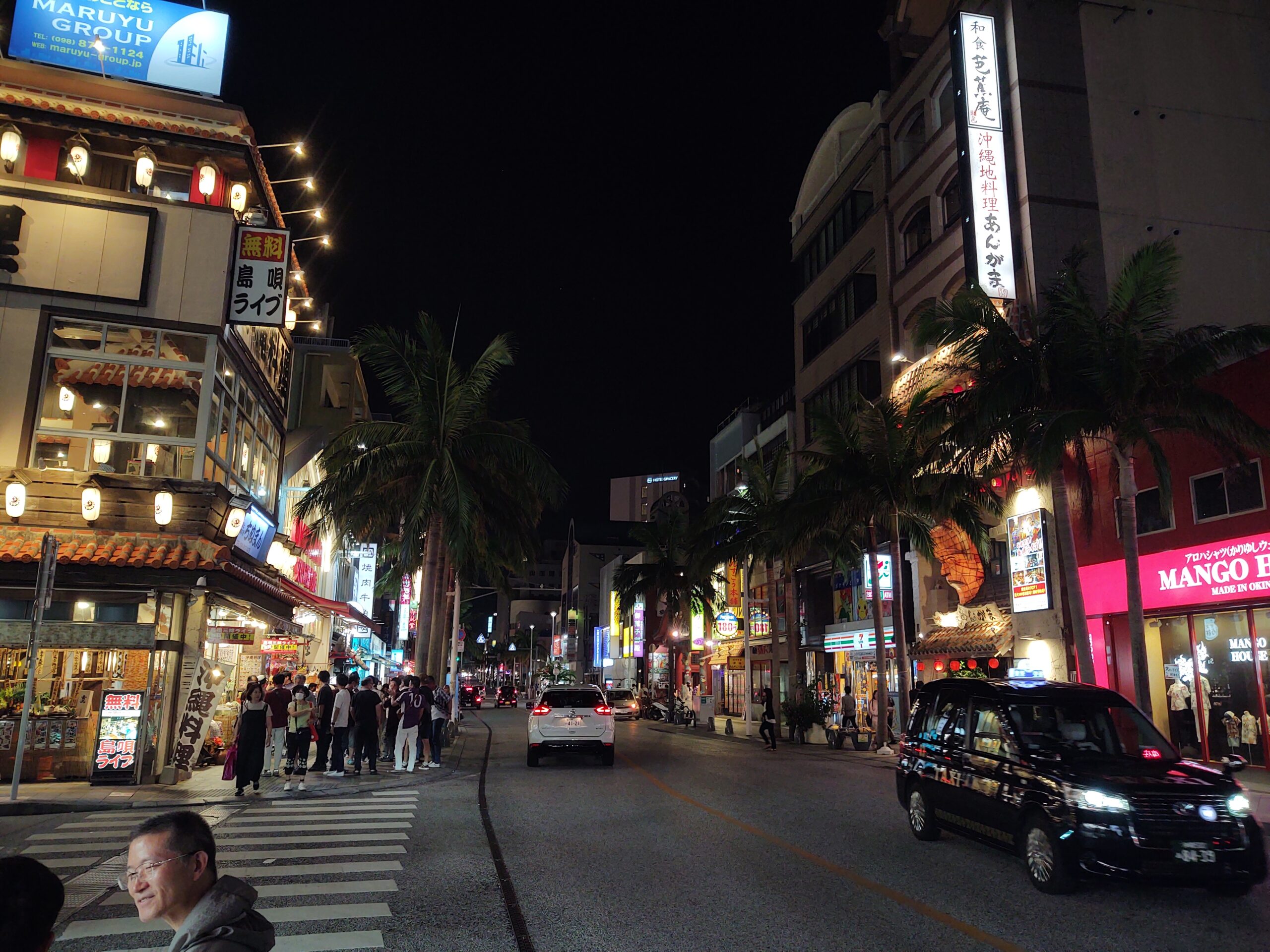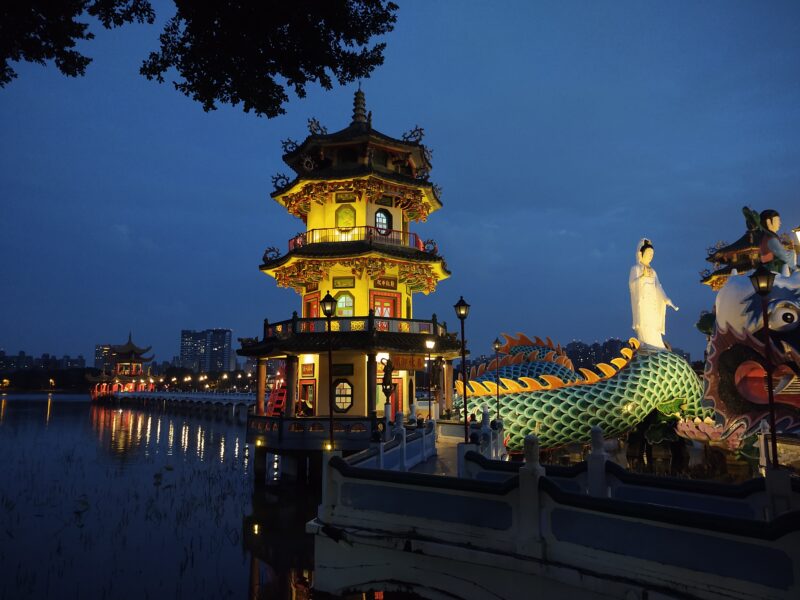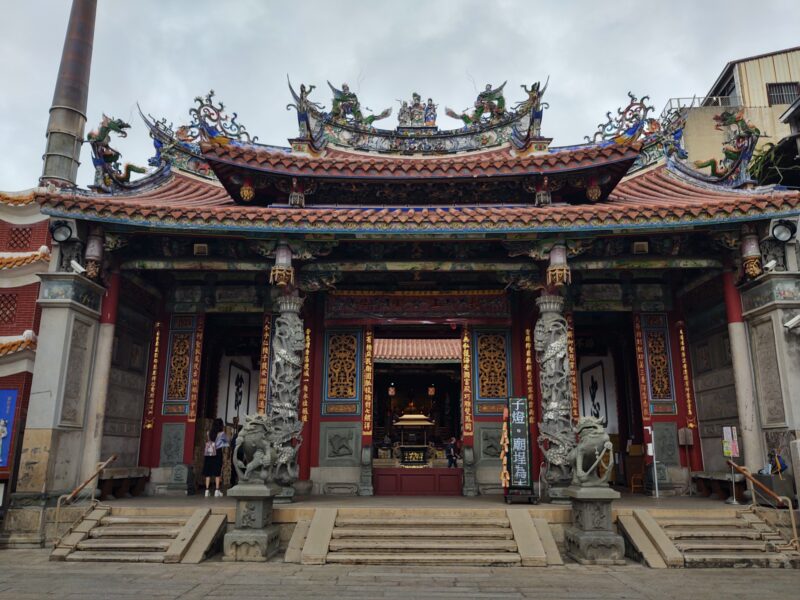Surprise!
Cream had been trying to guess for months where we were going, but I didn’t tell her until we finally arrived at the airport at the end of our Taiwan trip. I wanted to surprise her for our second anniversary – on our first, I showed up in Thailand while she thought I was in the Philippines.
I immediately knew we’d love Okinawa after a random promotional video I saw while flying Japan Airlines more than a year earlier. A beachy, laid-back island with an artsy culture, unique versions of Japanese food cooked with local ingredients, and warm, welcoming, and polite people – it sounded like a mix of everything we love most, and I knew we had to go.
Just an hour flight away from Taipei, we could fit it onto the end of our Taiwan trip. I neglected mentioning all this to Cream.
After spending so long on my Taiwan articles, it took me a while to think about how I wanted to present Okinawa. Our trip there was more about relaxing and soaking it all in than about sightseeing.
To give you a sense of the things and places we experienced, I decided to share some stories through 21 photos. These pictures bring back fond memories for me.
The trip was everything I’d hoped it would be – a much-needed escape from busy city life to a quiet, sub-tropical island with great food, fascinating culture, and welcoming people. Cream and I already want to go back to Japan to enjoy it all again.
1. Naha City
Our first tastes of Japan came as we took the monorail from the airport into downtown Naha, winding alongside a verdant canal.
Okinawa is one of Japan’s 47 prefectures (think: states/provinces). While it’s spread out among many islands, Okinawa Honto (main island) has the one big city – Naha, the prefecture’s capital.
2. Makishi Market
In the center of Naha stands Makishi Market, where dozens of souvenir and food shops sell their wares under the natural lighting of the arched skylight. It’s like a beachy, laid-back version of Milan’s famous Galleria.
Just after we arrived in Naha, we strolled through the cool shopping center with a taste of saltwater in the air, searching for our first meal.
3. Goya Chanpuru
I enjoyed goya chanpuru (stir-fry) several times on this trip. It’s the classic example of Okinawan cuisine, which is known for its unique interpretations of Japanese food using healthy local ingredients.
Goya, also known as bitter gourd, is balanced by sweet egg and protein-rich Okinawan tofu to make a fantastically light yet filling and tasty meal – that can even lower blood sugar. It’s thought that this ultra-healthy local specialty is a major factor in Okinawans’ long lifespan, which is the longest on Earth.
4. Shisa, the Guardian Spirits
The shisa is a symbol of the island and is sort of like Okinawa’s mascot – a mythical creature that is half-lion and half-dog. For hundreds of years, Okinawans have believed their spirits keep watch and protect everyone from evil and harm.
We shuffled under the shisa’s gaze everywhere we went, noticing them on nearly every house. Plenty more sat throughout the city, like quiet sentinels keeping guard.
5. Tsuboya Yachimun Pottery Street
Since the days of the Ryukyu kingdom, Okinawa has been known for its pottery, made with special local clay using a method that has been preserved for hundreds of years. One street in Naha, called Tsuboya Yachimun Street, is filled with pottery shops and ceramics crafted with local techniques.
We wandered and browsed through countless handmade and hand-painted bowls, plates, mugs, tea sets, shisa, and other pieces, admiring their understated yet elegant aesthetics. We picked up a pair of mugs that I still treasure today, with beautiful blue, white, and black tints resembling a tropical island.
6. Yachimun Dojo Pottery Class
One of my favorite parts of this trip was the opportunity to practice crafting our own Okinawan pottery. We took a two-day pottery class at Yachimun Dojo, tucked behind the hedges just off Tsuboya Yachimun Street.
In the quiet workshop, we shaped the clay on our first day and painted it on the second. Later, our plates were fired and sent to us in Australia. They came out pretty well!
7. Araha Beach
One warm evening, we sat in a park and soaked in the soft sea breeze while children played in the sand before the sunset.
Most of Okinawa Honto’s beaches are man-made but nonetheless beautiful. If you’re visiting Okinawa and have a bit more time than we did, you can also take ferries and planes to other islands dotted around the prefecture for even more remote settings, plus stunning natural beaches.
8. American Village
One of Okinawa’s claims to fame is that it houses several U.S. military bases, which led to some unique and amusing cross-culture. The American Village neighborhood is a Japanese tribute to all things American, including a Christmas shop open at all times of year.
It was fun to hang out there for a little while, and it was ironic to eat tacos for dinner in Japan after traveling for so long. Other than the novelties, American Village really does feel like the kind of beach town you’d see in Florida.
9. Shuri Castle
For most of history, Okinawans didn’t actually consider themselves Japanese. Instead, the island group was ruled by the Ryukyu empire.
Built in the 14th century, the Ryukyu’s Shuri Castle overlooks Naha. Much of it is still preserved today – or restored, like the beautiful gate that was destroyed in WWII. The archipelago was unified with the rest of Japan in 1972.
10. Above Naha
We calmly strolled around the Shuri Castle grounds. At the top, we caught some great views of Naha city and the ocean in the distance.
11. Katsudon
My favorite meal on this trip – and maybe in my entire life – was katsudon (pork cutlet over rice) with a local twist. Full of egg, veggies, and green onion, it was lighter yet more fragrant than a typical katsudon.
Next time you’re in Naha, I highly recommend Mikado for their incredibly delicious traditional Okinawan cooking.
12. Fukushuen Garden
As we aimlessly strolled around Naha one day, we came across Fukushuen Garden, a stunning Japanese garden right in the middle of the city. It was peaceful, green, and elegant, contrasted by the concrete buildings juxtaposed around it.
I later realized that Anthony Bourdain – a personal hero of mine – had come to this exact place when filming his Okinawa episode of Parts Unknown.
13. Naminoue Shrine
Continuing our aimless walk, we found Naminoue Shrine peacefully standing on cliffs above the ocean. It was decorated in a refreshingly different style than those we saw in Taiwan during our travels the previous weeks.
14. Itoman Fisherman’s Co-op
Cream & I indulged in tons of sushi, sashimi, and seafood on this trip, as of course one must when in Japan.
A favorite was the Fisherman’s Co-op in Itoman, where we got a huge sashimi platter with dozens of melt-in-the-mouth fresh pieces – all for about $7 USD. We also savored some delicious scallops, eel, and lobster, all at very reasonable prices and wonderfully tasty.
15. Itoman Beach
Just up the road from the Fisherman’s Co-op, Itoman Beach sparkled in a dazzling blue, lightened by the clear water and sand below. The Kerama Islands dotted the horizon. We sat for a while and stared out at the water, where planes flew in low to land at the airport, just a few minutes up the coast.
16. Okinawa Prefectural Peace Memorial Museum
We spent an afternoon at the Okinawa Prefectural Peace Memorial Museum, which detailed the Okinawan people’s history in WWII and since then. Their story was incredibly sobering.
A plaque by the door described it better than I ever could. It read:
The Basic Concept of the Okinawa Prefectural Peace Memorial Museum
In late March 1945, a fierce battle such as has rarely been seen in history took place on these islands. The “Typhoon of Steel” that lasted for ninety days disfigured mountains, destroyed much of the cultural legacy, and claimed the precious lives of upward of 200,000 people. The Battle of Okinawa was the only ground fighting fought on Japanese soil and was also the largest-scale campaign of the Asia-Pacific War. Even countless Okinawan civilians were fully mobilized.
A significant aspect of the Battle of Okinawa was the great loss of civilian life. At more than 100,000, civilian losses far outnumbered the military death toll. Some were blown apart by shells, some finding themselves in a hopeless situation were driven to suicide, some died of starvation, some succumbed to malaria, while others fell victim to the retreating Japanese troops. Under the most desperate and unimaginable circumstances, Okinawans directly experienced the absurdity of war and atrocities it inevitably brings about.
This war experience is at the very core of what is popularly called the “Okinawan Heart,” a resilient yet strong attitude to life that Okinawan people developed as they struggled against the pressures of many years of U. S. military control.
The “Okinawan Heart” is a human response that respects personal dignity above all else, rejects any acts related to war, and truly cherishes culture, which is a supreme expression of humanity. In order that we may mourn for those who perished during the war, pass on to future generations the historic lessons of the Battle of Okinawa, and convey our message to the peoples of the world, we thereby established, displaying the whole range of the individual war experiences of the people in this prefecture, the Okinawa Prefectural Peace Memorial Museum.
17. Ie Island
The following day, we took a trip up the coast. As we entered the Okinawa Churaumi Aquarium, Ie Island’s volcanic spire dominated the horizon. The view across the coastal reef shelves and ocean was stunning.
18. Jinta the Whale Shark
The highlight of Okinawa’s Churaumi Aquarium was Jinta, an enormous whale shark swimming around the deep-sea tank with dozens of sharks, manta rays, and schools of fish.
The aquarium was huge and very enjoyable. Besides these big guys, it also had turtles, dolphins (including a trick show!), manatees, and tons of different types of fish. It was one of the best aquariums I’ve ever been to and a real highlight to see so much marine life.
19. Nago Pineapple Park
We boarded a pineapple car and drove around Nago Pineapple Park’s grounds for one of Okinawa’s most famous experiences.
While the pineapples weren’t in season in October, it was still fun and quirky to be surrounded by essentially a pineapple-themed version of Disney-world, with grinning animatronic pineapples all over the place.
To add to the novelty, the Pineapple Park also contained a Dinosaur Adventure section where dinosaur animatronics played music in a band and bobbed their heads. Because…why not?!
20. One last dinner
As we wrapped up our trip, we sat back and enjoyed a last delicious local meal at a quiet restaurant in Naha.
We savored some local specialties one more time, including Okinawan agedashi tofu, purple sweet potato croquettes, goya stir fry, and shikuwasa juice – kind of like lemonade, made with a local citrus fruit.
We were the only patrons when we got there, and I’m pretty sure there was only one staff who first took our orders and then made the food. It tasted like classic home cooking, with that personal touch that goes beyond flavor.
21. Kokusai Dori by Night
We strolled down Kokusai Dori – the central shopping/downtown district of Naha – almost every night of our trip. We tasted the laid-back island life one last time, passing locals and soaking in all the lights and colors together under a cool ocean breeze.
The next day, we boarded our onward flight – first to Taipei, with a long layover to enjoy some more hotpot in Ximending – then onward to Melbourne, Australia.
We stayed in Australia for a year, but those stories are for another day. For now, I’ll reminisce a little longer on beautiful, warm Okinawa, and the wonderful time we had there.
Until next time,
Andrew


